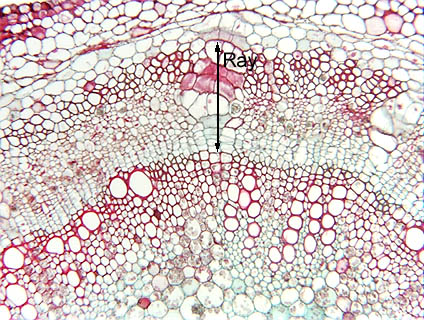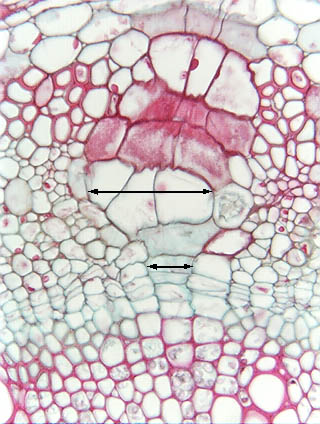 Fig.
16.3-1a and b. Transverse section of cotton stem (Gossypium).
As the vascular cambium produces secondary xylem and secondary phloem, the
pre-existing phloem from earlier years is pushed outward and stretched
circumferentially. It undergoes cell division and enlargement, a
process called dilatation growth when it occurs in secondary phloem or cortex
(note the spelling – this is “dilatation,” not “dilation”) and
it produces dilatation
tissue. If the parenchyma cells of the rays dilatate, that is called proliferative
tissue. If parenchyma cells in the axial masses of the phloem divide
and expand, that is called expansion
tissue. These two micrographs show proliferative tissue: at the
vascular cambium, the ray is uniseriate – one cell wide – as is the xylem
ray. But further out, the phloem ray is three cells wide (upper arrow in high
magnification micrograph): the extra cells are due to divisions of the ray cells
themselves. See pages 349 and 350 in Plant Anatomy for more details.
Fig.
16.3-1a and b. Transverse section of cotton stem (Gossypium).
As the vascular cambium produces secondary xylem and secondary phloem, the
pre-existing phloem from earlier years is pushed outward and stretched
circumferentially. It undergoes cell division and enlargement, a
process called dilatation growth when it occurs in secondary phloem or cortex
(note the spelling – this is “dilatation,” not “dilation”) and
it produces dilatation
tissue. If the parenchyma cells of the rays dilatate, that is called proliferative
tissue. If parenchyma cells in the axial masses of the phloem divide
and expand, that is called expansion
tissue. These two micrographs show proliferative tissue: at the
vascular cambium, the ray is uniseriate – one cell wide – as is the xylem
ray. But further out, the phloem ray is three cells wide (upper arrow in high
magnification micrograph): the extra cells are due to divisions of the ray cells
themselves. See pages 349 and 350 in Plant Anatomy for more details.